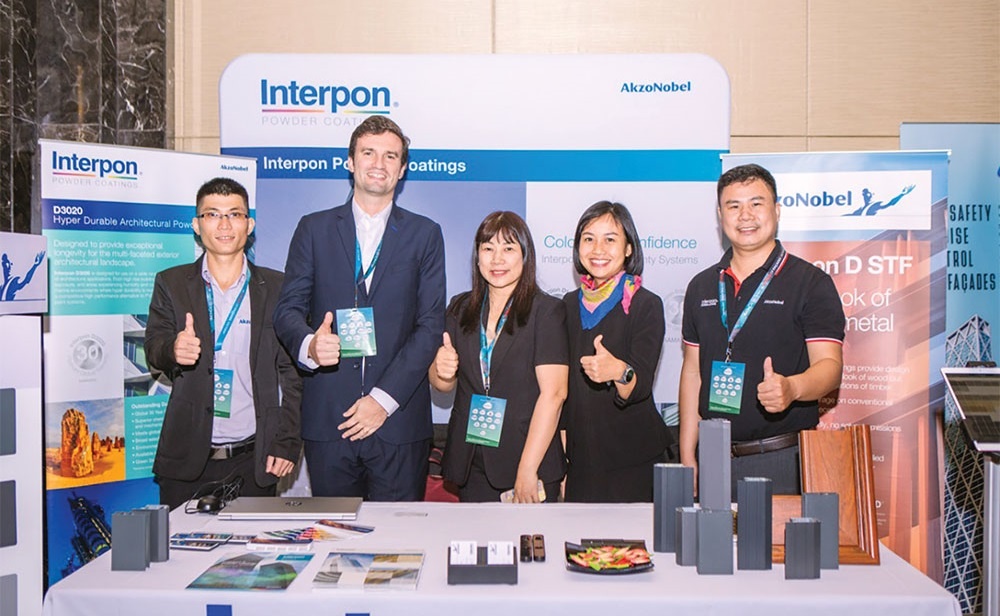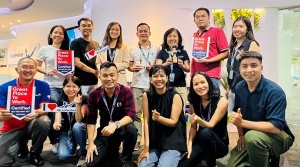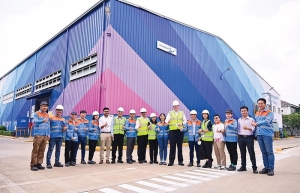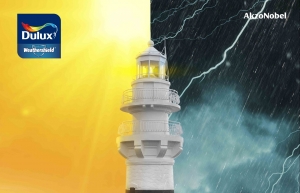AkzoNobel stays committed to sustainable innovations
As one of the associate partners of last week’s Zak World of Façades Vietnam, what role does the event play in promoting AkzoNobel’s regional powder coatings and sustainability strategy?
 |
| Maximilien Schréder, regional commercial director for Powder Coatings in South Asia at AkzoNobel |
AkzoNobel considers Vietnam as a key market and also a manufacturing hub in the region, with a laboratory and a major plant at the company’s site in Dong Nai, as well as a fresh powder coating factory in Bac Ninh, which further expands on the economic potential of the region. Products manufactured here serve not only domestic demand, but also other regional markets such as Indonesia, Malaysia, and Thailand.
Zak World of Façades Vietnam is an event that covers one of our core segments, architecture. For architectural customers, we have specific powder coating offers for façade, fencing, railing, cladding, windows frames, and doors, as well as louvres and even other steel structures. As an official partner of Zak, we looked forward to meeting the leading architecture players at the event.
If you look at the development of Vietnam during the past 10 years, cities like Ho Chi Minh City have seen a surge in high-rise buildings, and it’s critical for us to be present. Powder coatings protect and enhance parts of a building and the building’s environment, and it’s an important segment for us for which we also offer warranties that can range from 10 to 30 years. It’s an industry with various innovations, and the event looked mainly at landmark buildings, such as high-risers. I would say, the event tackled the high-end market; however, innovations made here can also transfer into residential and lower-end projects.
Part of AkzoNobel’s approach to product design with powder coatings are the Interpon D warranties. Could you explain how these work, and what happens in case checking or cracking does occur?
I’m glad you’re asking this question because this is our key differentiation. However, it may also be a bit new for the Vietnamese market. We offer a warranty on the colour, and we want the warranty to match the life cycle of the assets, whether that’s 10, 20, or 30 years. The coated product – may it be a door or window – will retain its colour and gloss within a subset of parameters. But for that, you need to ensure very robust coatings and a perfect application so that they can withstand the elements in each region.
For instance, in Australia with its high UV index, we are quite confident that the powder coatings we apply can actually deliver what we promise. However, this is an entire industry that makes sure that our powder coatings are applied correctly. We have certified coaters and technical teams that must be at relevant sites almost every month to ensure that the application is executed flawlessly, as this is essential for a uniform, strong performance of our product.
To this end, we’ve created the Interpon Applicator Network, which is an exclusive group of powder coatings’ experts to help choose and apply the right system. Being an Interpon Approved Applicator requires the coater to submit to a series of audits of their powder line, to ensure their continued compliance with excellence. Customers can receive a warranty if the powder coatings had been applied by an Interpon D Approved Applicator.
This is carried out so that the end customer will get a product which is defect-free. If there is a quality problem, we will be there with the customer and solve it, as it’s backed by the warranty. Fortunately, I have seen very few cases where we need to be there and solve such a problem.
It’s about educating the market – what’s your liability as a builder, and what do you want? If you build a 50-storey building and in eight years you need to re-coat all the chassis and doors, it means you will most likely never be done, and the liabilities can far exceed the costs of proper coatings. So, it’s not the right choice.
Thus, our warranty is an end-to-end product, and is about saving those costs. And that’s also where the sustainability argument comes into play. Because if you buy something cheap, but in seven years, you need to change it, that’s not very durable and sustainable. After all, the most sustainable use of assets is to keep using them.
 |
| AkzoNobel was present at last week’s Zak World of Façades Vietnam in Hanoi |
Among many other products, AkzoNobel features a series of powder coatings for buildings. Could you elaborate on some examples and how these relate to the sustainable development of cities around the globe, particularly in Southeast Asia?
Interpon powder coating products come with sustainability benefits. They are designed for durability, gloss retention, and colour stability, and are also well-known for having a high utilisation of material of up to 99 per cent.
They contain no volatile organic compounds and have a small CO2 footprint. It makes them an attractive option for customers concerned with sustainability in their projects, such as architects and specifiers.
The consistency of finish, operational efficiency, and price are often of greater concern to fabricators, but Interpon powder coatings deliver on all three counts. The latest generation of our high-performance products protect architectural designs for up to 30 years and come with the performance warranties and industry certifications to match. The ability of powder coatings to reflect the appearance of wood, metal, or stone mean those precious natural resources aren’t necessary to achieve the desired effect.
With our superdurable Interpon D Futura and Interpon D Flat Matt and hyperdurable Interpon D Anodic powder coatings, the concept is about extending the quality of coatings to enable assets to be used longer. Of course, the best and most sustainable option is to not generate any waste with our products. For instance, we have made a conscious choice, not to use lead in any of our pigmentations and not to use certain raw materials if they come from areas which do not respect UN values, deploy child labour, have similar issues.
To me, it is very difficult to talk about sustainability alone because it is so much embedded into the value of what we offer. For AkzoNobel, virtually the whole powder coating division is about the sustainability benefits of the products, as they generate almost no harmful waste during application. They also require less space to transport than liquid, and surfaces finished with a powder coatings are generally easier to clean and more resistant to marring, reducing the need for touch-ups on site. They also contribute directly to LEED and BREEAM points for green buildings in architectural projects and, in the case of Interpon D, come with an Environmental Product Declaration, the ultimate benchmark in sustainability.
What are AkzoNobel’s key sustainability targets for the next decades?
If we look at our key sustainability ambition by 2030, I’m proud to work for a company that sets these targets reasonably close in the future. We aim to reduce carbon emissions in our operations and the entire value chain by 50 per cent by 2030 (with the baseline being 2018), achieve half of our revenue from sustainable solutions, move towards zero waste, and help empower more than 100,000 people in local communities through education. Beyond 2030, we aim to be carbon neutral by 2050. The greatest challenge for us, however, is not so much our operation because that has minimal impacts – the larger impacts actually come from customers and suppliers.
We also have the ambition to make sure consumption of natural resources is reduced as much as possible, especially when it comes to one of the planet’s most precious commodities, water. Manufacturers are working hard to reduce fresh water consumption and use recycled water wherever possible. They are similarly looking to reduce the amounts of raw materials used in developing the end products or create products based on recycled or renewable raw materials. AkzoNobel has the ambition to produce zero non-reusable waste by reducing, reusing, and renew wastewater at our all of our water-intensive sites. We’re on track to get there.
Within the powder coatings industry, suppliers are being encouraged and monitored on their selection and purchase of raw materials, and how and from where these are sourced and distributed.
Customers are similarly encouraged and supported in their own environmental, social, and governance goals through powder coating products.
 | AkzoNobel Vietnam certified as Great Place To Work AkzoNobel Vietnam has been certified as a Great Place to Work® for its employee-validated work environment, proving the company's strong commitment to its People.Planet.Paint approach to its employees. |
 | AkzoNobel aiming for inclusive, sustainable growth On July 7 and 8, Michael Friede, chief commercial officer at AkzoNobel, visited some of the company’s manufacturing sites and partners in Vietnam. On this occasion, he spoke to VIR’s Etienne Mahler about the company’s philosophy for holistic, sustainable, and inclusive development in this country. |
 | AkzoNobel Vietnam protects Cu Lao Xanh lighthouse from harsh weather AkzoNobel, the leading global paints and coatings company and the major producer of Dulux brand, has completed repainting the Cu Lao Xanh Lighthouse project with Dulux Weathershield. It is the third lighthouse in Vietnam recoated under the “Lighthouse Protection Campaign” of AkzoNobel. |
What the stars mean:
★ Poor ★ ★ Promising ★★★ Good ★★★★ Very good ★★★★★ Exceptional
Related Contents
Latest News
More News
- Five tech predictions for 2026 and beyond: new era of AI (December 11, 2025 | 18:16)
- CONINCO announces new chairman and CEO (December 10, 2025 | 11:00)
- How AWS is powering the next-gen data era (December 09, 2025 | 13:14)
- Outlook in M&A solid for Singapore (December 08, 2025 | 10:31)
- Vietnamese firms are resetting their strategy for global markets (December 05, 2025 | 17:04)
- LPBank Securities accelerates AI and data innovation with AWS (December 05, 2025 | 09:00)
- Improving traceability capacity with Zebra Technologies (November 26, 2025 | 10:08)
- Ho Chi Minh City engages 500 CEOs in dialogue on building global megacity (November 25, 2025 | 16:00)
- CEO shares insights on Phu My 3 IP’s journey to green industrial growth (November 17, 2025 | 11:53)
- NS BlueScope CEO highlights decade of sustainable steel efforts (November 15, 2025 | 10:00)

 Tag:
Tag:





















 Mobile Version
Mobile Version